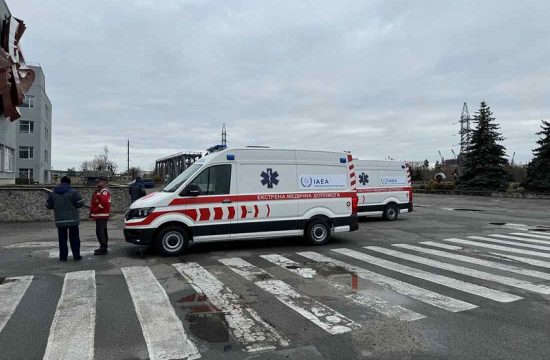Geneva— The European Laboratory for Particle Physics (CERN) inaugurated its new state-of-the-art facility for science education and outreach, Today. In the inauguration event, CERN debuted Science Gateway to the President of the Swiss Confederation, ministers and other high-level authorities from CERN’s Member and Associate Member States, the project’s donors and partners in CERN’s research, education and outreach.
It is designed by world-renowned Renzo Piano Building Workshop, the new facility is open to visitors from around the world, from the age of five and upwards. It will allow CERN to significantly expand its portfolio of educational and outreach activities. CERN Science Gateway will be open to the public as of tomorrow, 8 October 2023.

Fabiola Gianotti, CERN Director-General, who stressed the value of education and outreach with the public. “Sharing CERN’s research and the beauty and utility of science with the public has always been a key objective and activity of CERN, and with Science Gateway, as of tomorrow, we can expand significantly this component of our mission,” She said.
“We want to show the importance of fundamental research and its applications to society, infuse everyone who comes here with curiosity and a passion for science, and inspire young people to take up careers in Science, Technology, Engineering and Mathematics (STEM)” she added. “Science Gateway will be a place where scientists and the public can interact daily. For me, personally, Science Gateway is a dream that has become a reality and I am deeply grateful to all the people who have contributed, starting with our generous donors.”
CERN is the home of the c, the world’s largest and most powerful particle accelerator.
In his address, the President of the Swiss Confederation, Alain Berset, said: “Those familiar with Venn diagrams will agree that this invisible circle puts CERN at the intersection between Switzerland, France and Europe, thus symbolising its commitment to shared scientific and political values. CERN truly is an exceptional facility and one that enables Switzerland and Geneva to shine on the world stage.”
The iconic building, inspired by the tubular structure of CERN’s accelerators, comprises five areas housing exhibitions, laboratories and an auditorium that can be flexibly configured into different spaces depending on requirements, as well as a shop and a restaurant.
The transparent glass panels and bridges further represent CERN’s commitment to collaboration across borders and culture and open science that is accessible to all.
Renzo Piano, chief architect of the project, said: “This will be a place where people meet: kids, students, adults, teachers and scientists, everybody attracted by the exploration of the Universe, from the infinitely vast to the infinitely small. It is a bridge, in both a metaphorical and a real sense. This building is fed by the energy of the Sun, landed in the middle of a newly grown forest.”
Not only is the building visually striking, but CERN and the architects committed to it being fully carbon neutral, and almost 4000 square metres of solar panels supply more power than the building’s needs. Over 400 trees have been planted, situating the whole campus in a living forest.
While the full project was launched in 2018, construction of the Science Gateway campus took just over two years, with the first stone of the building being laid on 21 June 2021.
This new facility would not have been possible without the generous support of the CERN Science Gateway sponsors, who share the same values and, through their contributions, want to pay tribute to education and knowledge for the benefit of society.
The overall cost of Science Gateway was about 100 million Swiss francs, and this was funded exclusively through donations. In particular, the Stellantis Foundation is the largest single donor and contributed 45 million Swiss francs towards the project.
John Elkann, Chairman of Stellantis, said: “CERN is an example of how we can work together in harmony, using scientific knowledge and ingenuity for the greater good. Stellantis Foundation is proud to partner with such an institution as it opens to the public the new Science Gateway, which also celebrates a great innovator like Sergio Marchionne. My family and I strongly believe in the power of education, which is the mission of the Fondazione Agnelli : a commitment we reinforce today with conviction and passion.”
As part of wider society, Stellantis takes action to advance human achievement. Stellantis, through its philanthropic activities and its Foundation, invests in individuals through education projects that spark innovation and excellence.
The Fondation Hans Wilsdorf is also a major donor. Other donors are the LEGO foundation, the Loterie Romande, Ernst Göhner Stiftung, Rolex, the Carla Fendi Foundation, the Fondation Gelbert, Solvay, the Fondation Meyrinoise du Casino and the town of Meyrin. CERN thanks the République et Canton de Genève and the CERN and Society Foundation for their support.
The ceremony took place in the new 900-seat auditorium, named after Sergio Marchionne, former CEO of Fiat Chrysler Automobiles, who recently passed away. Guests visited the education laboratories and the unique immersive exhibitions and enjoyed the Big Bang Café, the Collider Circle square and other areas of the Science Gateway campus.
Throughout the day, guided by CERN scientists and children of CERN personnel, visitors were able to experience first-hand the range of Science Gateway’s opportunities, from interactive exhibitions to laboratories for hands-on experiments and immersive spaces.
They also had the opportunity to appreciate CERN’s scientific breakthroughs and technologies, learn about the history of the Universe and admire the mysteries of the quantum world. Teenagers guided guests through various enquiry-based laboratory activities throughout the afternoon.
Eliezer Rabinovici, President of the CERN Council, speaking on behalf of CERN’s Member and Associate Member States, said: “Today we celebrate the courage and passion to innovate that CERN has always demonstrated and the commitment to share the fruits of its research with people from all countries and of all ages. May the science leaders of tomorrow come from among the curious children who will fill this wonderful place with joy in the coming years.”
The new centre is expected to host up to 500 000 visitors a year from across the world. Science Gateway will be free of charge and open 6 days a week, from Tuesday to Sunday.








